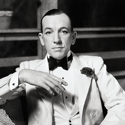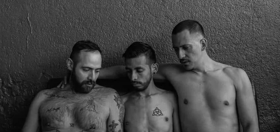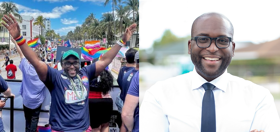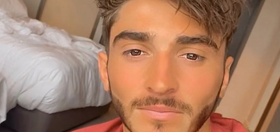
Gay Indians no longer live in fear. Well, not as much.
Despite the nation’s tenacious colonial ban on homosexuality, Section 377, more gays and lesbians are living their lives in the open.
Last week’s gay pride march, which once stopped traffic – and soccer games – went off without a hitch. Yes, some troublesome bikers tried to stir the shit, but coppers shooed them away. Times certainly have changed.
Outside the pride context, gay social groups have started popping up in urban areas, such as Delhi. Every Sunday, about 10-15 men show up to exchange advice, chit chat and, most importantly, be seen.
One man, a 41-year old named Ranjan, tells Indian Express:
How about we take this to the next level?
Our newsletter is like a refreshing cocktail (or mocktail) of LGBTQ+ entertainment and pop culture, served up with a side of eye-candy.
When we decided to start the Socials about a year ago, it was a conscious decision to be visible, to hold our gatherings in the day in a coffee shop. It was our way of pushing for a bit of public space.
The relative tidal wave of gays may owes its impetus to India’s premier gay, Prince Manvendra Singh Gohil.
Gohil made international headlines when he came out last year. Since then, he’s become an outspoken advocate of lavender visibility. Not surprisingly, his regal parents didn’t understand. King Ragubir Gohil Singh told his only son:
It’s not natural. Anything which is not natural, is not something which you can’t procreate, you can’t have children because it is not something which one is meant for. Otherwise there’ll be no life on this earth.
Gohil would not be dissuaded.

The prince survived a mess of a marriage and could no longer live a lie. And urge others to come out of the shadowy closet:
I came out in the newspapers openly that I’m gay and basically [because] I wanted to show to the world that even a prince can be gay. I wanted people to discuss homosexuality, which was always considered a taboo and a stigma… It’s been existing in India but no one talked about it.
Of course, Gohil had a family name – and fortune – on which he could fall back. Not all Indians are so lucky. And its clear in the newly out demographic. According to Indian Express, the majority of the out ‘mos share three traits: “mostly urban, English-speaking and privileged”. Rural queers, meanwhile, continue to live isolated, closeted lives.
This out urbanite trend has as much to do with safety nets as it does with India’s changing economy. 53-year old photographer Sunil Gupti says,
Homosexuality worldwide has been an urban phenomenon. In India, the economic change has had a knock-on effect. More and more young people live alone. A lot of them earn quite well. They make up a consumer class that is used to getting what it wants–and they will set the bar. In the middle of this change, there is the possibility of a gay lifestyle.
A young man named Avanti experienced this first hand – “When I started earning, my parents asked me fewer questions”.
While affluent gay men flourish, lesbians continue searching for their queer space. Yes, there are some nightclubs, but public, visible space alludes them. A lady lover and gay activist named Maya laments,
We are silenced, not closeted. Public spaces are inaccessible for women. We don’t even put up stickers advertising our helpline number at any public place, be it a coffee shop or cinema, because we know a woman will not stand up in a public place and scribble that number down. There is always the fear that too many people are watching.
A handful of groups, like a ten-year old organizations called Club Labia, hope to raise Indian lesbians to new, public heights. Labia, for example, holds monthly screenings that entertain, educate and, most importantly, socialize India’s nascent lesbian communities.
The increased visibility of gays have unfortunately sparked a rise in anti-gay crime:
The growing visibility in Kolkata has come at a price. Over the last three months, at least six cases of crime against members of the community have been reported. The victims have been mugged, mobbed, tortured by the custodians of law, and in the case of cross-dresser Ronald D’Silva, brutally murdered.
Gays are an obstinate bunch, however, and the urbanites show no sign of disappearing. Hopefully they’ll encourage more ‘mos to join the party – an estimated 80% of gays are currently married to women.
While some Indian gays are out and about, there’s always room for more.


















Comments are closed.